Gathered with our people
Death brings to the fore the cost of having left home.
Death brings to the fore the cost of having left home.
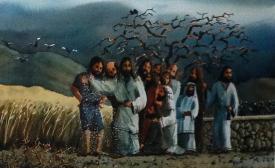
The plaque accompanying the painting reads: ‘“Congregation” by Tom Neufeld, pastor of TUMC, 1976-1979. Presented to CMU by members of Thompson [Man.] United Mennonite Church.’

George Epp, Ted Redekop and Jack Crolly—members of Thompson (Man.) United Mennonite Church from the 1970s—ski together. (Photo courtesy of the Mennonite Heritage Archives)
What do you get when you start a Mennonite church in the middle of nowhere? A community that is still going strong more than 50 years later, even after the church itself has closed its doors.
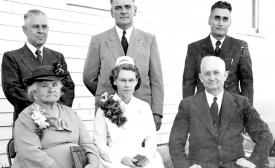
Anna Dyck, front row centre, was ordained on Sept. 6, 1953, at North Star Mennonite Church in Drake, Sask. Seated beside Dyck are her mother, Suzanna Dyck, and J. J. Thiessen. Standing, from left to right: H. S. Bartel; Paul Schroeder, North Star Mennonite pastor at the time; and Hans Dyck. (Photo courtesy of Grace MacDougall)
At a time when a woman’s sphere of influence was limited to hearth and home, Anna Dyck was making a difference.
Dyck spent nearly 40 years of her life as a missionary in Japan. During those years she lived in three communities and worked as a nurse, Bible teacher, pastor and church planter. She helped establish four congregations that are still in existence today.
At the age of 18, most young people are making the transition from high school to whatever comes next. It’s a formative time with many possibilities. So Canadian Mennonite asked eight people: “If you could give your 18-year-old self some advice, what would you say?” This is how they responded.

Etch Your Own Stone is the follow-up to Sparky and the Plugs’ 2016 eponymous debut album. (Photo by Judith Schulz)
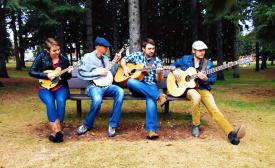
Jill Wiens, left, Curtis Wiens, Zac Schellenberg and Clay Buhler are Sparky and the Plugs. (Photo by Aleta Schellenberg)
How will people remember you when you die?
That’s the question at the heart of “Stone Cutter,” one of the key tracks on Etch Your Own Stone, the new album from Saskatoon bluegrass quartet Sparky and the Plugs.
In the song, written by banjo player Curtis Wiens, the singer contemplates how he will spend his time on Earth.
Oh God of Love,
Maker of human neighbours and neighbourhoods,
Hear our prayer
from the Danforth, for the Danforth.
Originally, they were made of pieces of broken glass from the rubble an Israeli tank left behind when it slammed into the gift shop at the International Centre of Bethlehem (ICB) in 2002. Today the glass angels of peace are made of used bottles and have emerged into a small business enterprise employing around 50 people in the Bethlehem area.

Larry and Marg Dyck participate in the Grow Hope Niagara project of Canadian Foodgrains Bank. They donate use of the land and farm it with the financial help of urban sponsors. The income generated goes to the hunger relief efforts of Mennonite Central Committee Canada. (Canadian Foodgrains Bank photo)
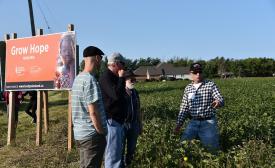
Grow Hope Niagara farmer Larry Dyck hosts city-dwelling sponsors who visit the farm to see the crop and learn more about the project and farming. Their financial support helps cover the cost of seeds and fertilizer so that all proceeds of the crop can be donated to relieve world hunger. (Canadian Foodgrains Bank photo)
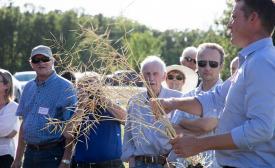
Grant Dyck is the main farmer of Canadian Foodgrains Bank’s Grow Hope Manitoba near Niverville, Man. At the annual harvest celebration, he tells urban sponsors about the canola crop he raised to help relieve world hunger. The funds raised in Manitoba go toward the hunger relief efforts of MCC Canada. (Photo by Bethany Daman)
Fifteen acres of wheat and a good cause—that’s what brought nearly 200 people together in Pembina Crossing, Man., in June 2018.
Some drove two hours from Winnipeg, others five minutes from their rural homes. Most came from Anglican church communities in Winnipeg.
What surprised me the most at the graduate student conference hosted by the Toronto Mennonite Theological Centre (TMTC) on June 14-16 was the prayer gathering that happened each morning. I expected that only two or three people would appear, but I was wrong; more than 20 people came. Of course, not everyone attended but a large number of people joined.

SangMin Lee is believed to be the only Korean Mennonite to choose jail over military service. He was released in July 2015, after serving 15 months of an 18-month sentence. In June 2018, the Constitutional Court of Korea ruled against the practice of imprisoning conscientious objectors. (Mennonite World Conference photo)
The Constitutional Court of Korea brought an end to 70 years of imprisoning conscientious objectors when it ruled June 28 that it is unconstitutional for South Korea not to offer alternative service options for COs.
It is estimated that about 20,000 males have been punished for refusing military service since the first draft laws were enacted in 1950.